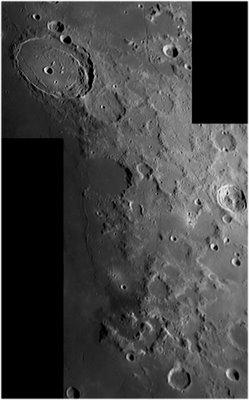 Posidonius is a lunar impact crater that is located on the western edge of Mare Serenitatis, to the south of Lacus Somniorum. The Chacornac crater is attached to the southeast rim, and to the north is Daniell crater.
Posidonius is a lunar impact crater that is located on the western edge of Mare Serenitatis, to the south of Lacus Somniorum. The Chacornac crater is attached to the southeast rim, and to the north is Daniell crater.The rim of Posidonius is shallow and obscured, especially on the western edge, and the interior has been overlaid by a lava flow in the past. The crater ramparts can still be observed to the south and east of the crater rim, and to a lesser degree to the north.
There is a smaller, semi-circular rim of a concentric, flooded crater within the main rim, offset toward the eastern edge. There is no central peak, but the floor is hilly and laced with a rille system named the Rimae Posidonius. The floor is also slightly bulged due to the past lava uplift, which also likely produced the complex of rilles. The northeast rim is interrupted by the smaller crater 'Posidonius B'. Within the crater rim, offset just to the west of center is another smaller crater 'Posidonius A'.
On the Mare Serenitatis surface near Posidonius crater is a notable system of wrinkle-ridges that parallel the nearby shore. These are designated the Dorsa Smirnov. At the peak of these ridges is a small craterlet with a diameter of 2 km. This craterlet is surrounded by a patch of high-albedo material, and is an example of a lunar bright spot. This peak was formerly designated Posidonius Gamma (γ).
The Posidonius Gamma feature was first observed by the lunar cartographer Julius Schmidt in 1857. He noted the similarity to the bright patch surrounding Linné crater.
Wikipedia

